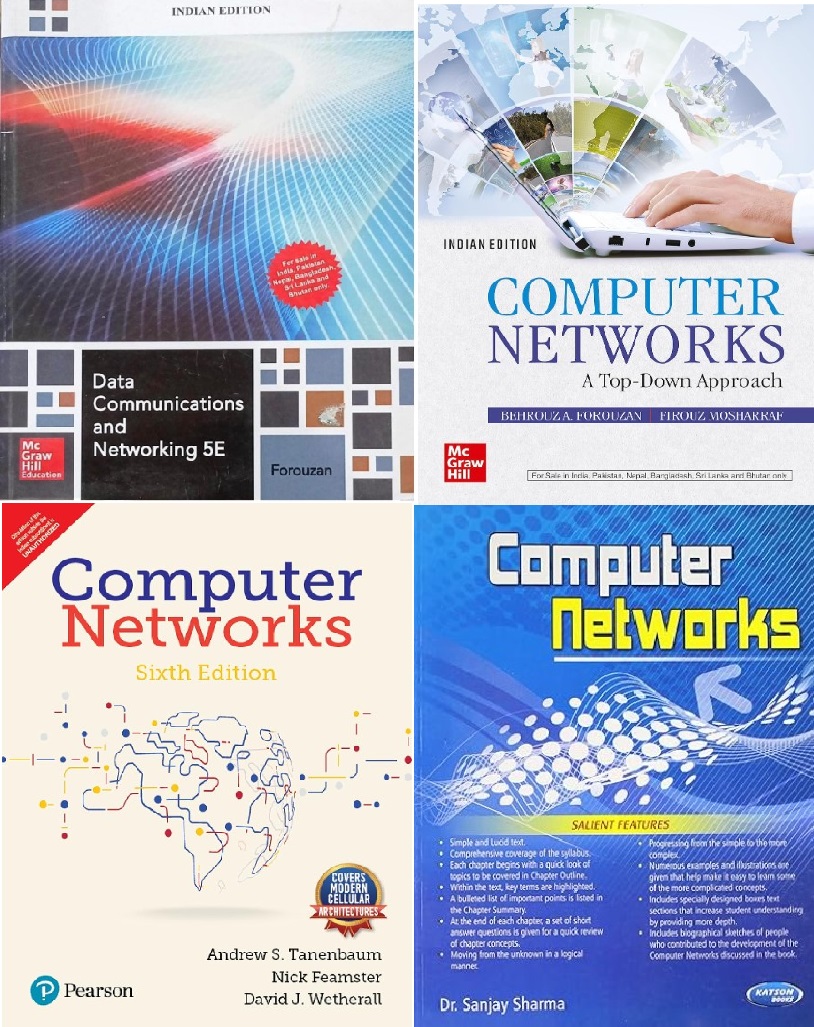Unit 1
Introduction to Data Communication Definition: Effectiveness, Basic Communication Components. Network Architecture Definition, History, Criteria, Goals and Applications of Networks, Categories of networks, Organization of the Internet, ISP, Protocols and standards, The OSI reference model, TCP/IP protocol suite, Network devices and components. Network topology design, Types of connections.
Q41 – Protocols are
Agreements on how communication components and DTE’s are to communicate
Logical communication channels used for transferring data.
Physical communication channels used for transferring data
None
Ans – (1)
Explanation – Protocols define the rules and conventions for communication between network devices, ensuring proper data transmission and reception.
Q42 – Which one of the following networks uses dynamic or adaptive routing?
TYMNET
ARPANET
SNA
None
(Timothy Williams, McGraw Hill Education)
Ans – (2)
Explanation – ARPANET, which was one of the earliest wide-area packet-switching networks, implemented dynamic or adaptive routing protocols.
These protocols allowed the network to dynamically adjust its routing decisions based on factors such as network topology changes, link failures, and varying traffic conditions.
This adaptive routing capability was crucial for ARPANET to efficiently transmit data between its various nodes.
Q43 – Which of the following is not true regarding service provided by TCP?
TCP guarantees delivery all the packets
TCP service is connection oriented
TCP guarantees that a sending process is permitted to transmit at any rate
TCP does not provide any delay guarantee i.e. how long the data may take to get to destination.
Ans – (3)
Explanation – TCP (Transmission Control Protocol) is a connection-oriented protocol that ensures reliable delivery of packets. It guarantees that all packets are delivered (option 1) and maintains a connection-oriented service (option 2).
However, TCP does not allow a sending process to transmit at any rate it desires. Instead, it employs flow control and congestion control mechanisms to manage the rate of data transmission to avoid network congestion and ensure efficient data transfer. Moreover, TCP does not provide any guarantees regarding the delay of data delivery (option 4).
Q44 – The part of OSI where one most commonly finds data encryption, compression, and other encoding for network communication is
Application layer
Session layer
Presentation layer
None
Ans – (3)
Explanation – The Presentation Layer is the sixth layer of the OSI (Open Systems Interconnection) model. It is responsible for the translation, encryption, and compression of data. This layer ensures that data sent from the application layer of one system is readable by the application layer of another system.
Q45 – Pick the incorrect statement
Another name for primary-secondary protocol is master-slave.
Perr to peer protocol provides equal status to all sites on the channel.
Priority, non-priority types come under master slave protocol.
TDM is a primary secondary non-priority system.
Ans – (3, 4)
Explanation –
- Another name for primary-secondary protocol is master-slave. This is correct. The primary-secondary protocol is indeed also referred to as master-slave.
- Peer to peer protocol provides equal status to all sites on the channel. This is correct. In a peer-to-peer protocol, all sites have equal status and can initiate communication.
- Priority, non-priority types come under master-slave protocol. This statement is incorrect. Master-slave protocols generally do not categorize into priority and non-priority types in the context implied here.
- TDM is a primary secondary non-priority system. This statement is also incorrect. Time Division Multiplexing (TDM) is a method of transmitting multiple signals over a single communication channel by dividing the time into slots. It is not inherently related to primary-secondary or priority-based systems.
Q46 – Pick the correct statement
A switched circuit is a dial up circuit that may encounter blockage (busy signal).
Non switched leased line supports higher data volume and quality than switched lines.
Non switched lines are expensive for high volume data.
Switched circuit provides faster response time.
(Williams Timothy, McGraw Hill Education)
Ans – (1, 2)
Explanation –
Statement 1 – Switched circuits, like dial-up connections, can indeed encounter busy signals when the line is already in use.
Statement 2 – Non-switched leased lines are dedicated connections that typically offer higher data capacity and reliability compared to switched lines, making them suitable for consistent, high-volume data transfer.
Q47 – FDDI used which type of physical topology?
Bus
Ring
Star
Tree
Ans – (2)
Explanation –
FDDI (Fiber Distributed Data Interface) uses a dual-ring physical topology.
This means it has two rings, one for sending data in one direction and the other for sending data in the opposite direction. This setup helps in providing a backup in case one ring fails.
Q48 – Match the following
1 Session layer
2 Transport layer
3 Application layer
4 MDI (Medium Dependent Interface)
(i). connects DCE into physical channel
(ii). Provides end to end accountability
(iii). Provides organised means to exchange data between users. (like synchronisation points)
(iv). Supports an end user process and performs required file transfer.
1-(iii), 2-(iv), 3-(ii), 4-(i)
1-(iii), 2-(ii), 3-(iv), 4-(i)
1-(ii), 2-(iv), 3-(i), 4-(iii)
1-(iv), 2-(iii), 3-(ii), 4-(i)
Ans – (2)
Explanation –
Session layer – This layer (iii) provides an organized means to exchange data between users. It establishes, manages, and terminates connections between cooperating devices, providing synchronization points in the data exchange.
Transport layer – This layer (ii) provides end-to-end accountability. It ensures that data is reliably delivered from the source to the destination, handling issues such as data integrity, error correction, and flow control.
Application layer – This layer (iv) supports an end-user process and performs required file transfer. It is responsible for providing network services directly to the end-user application, including services such as file transfer, email, and web browsing.
MDI (Medium Dependent Interface) – This layer (i) connects DCE (Data Communications Equipment) into a physical channel. It refers to the interface that connects networking devices (such as computers or routers) to the physical transmission medium (such as Ethernet cables or fiber optics).
Q49 – The number of cross point needed for 10 lines in a cross point switch which is full duplex in nature and there are no self-connection is
100
45
50
90
(Timothy Williams, McGraw Hill Education)
Ans – (2)
Explanation – To calculate the number of cross points needed for a full-duplex cross-point switch with 𝑛 lines and no self-connections, we can use the formula
Number of cross points = 𝑛(𝑛−1)/2
Given that there are 10 lines,
Number of cross points = 10(10−1)/2 = 45
Q50 – The standard suit of protocols used by the Internet, Intranets, extranets and some other networks.
TCP/IP
Protocol
Open system
Internet work processor
Ans – (1)
Explanation –
The standard suite of protocols used by the Internet, Intranets, extranets, and some other networks is TCP/IP (Transmission Control Protocol/Internet Protocol).
TCP/IP provides the fundamental communication language for networks, enabling devices to communicate and exchange data with each other over the Internet and other interconnected networks.
Q51 – Ethernet system uses which of the following technology.
Bus
Ring
Star
Tree
Ans – (1)
Explanation – The traditional Ethernet system originally used a Bus topology. In this setup, all devices are connected to a single central cable, called the bus, and data is sent to all devices on the network.
Q52 – In a……………. topology, if there are n devices in a network, each device has n-1 ports for cables.
Mesh
Star
Bus
Ring
Ans – (1)
Explanation – In a Mesh topology, if there are n devices in a network, each device has n−1 ports for cables.
In a mesh topology, every device has a dedicated connection to every other device in the network, so the number of ports required on each device is equal to the total number of devices minus one (since it doesn’t need a port to connect to itself).
Q53 – If all devices are connected to a central hub, then topology is called
Bus Topology
Ring Topology
Star Topology
Tree Topology
Ans – (3)
Explanation – If all devices are connected to a central hub, the topology is called a Star topology. In a star topology, each device has a direct connection to the central hub, and the hub manages the communication between devices.
Q54 – The topology with highest reliability is
Bus
Star
Mesh
Ring
Ans – (3)
Explanation – In a mesh topology, each node is connected to multiple other nodes, providing multiple paths for data to travel. This redundancy ensures that if one path fails, there are other paths available for communication, making it highly reliable.
Q55 – Which of the following is the logical topology?
Bus
Tree
Star
Both A and B
Ans – (3)
Explanation –
The logical topology refers to how the devices communicate with each other in a network, regardless of their physical arrangement.
Among the options provided
Bus and Tree are both physical topologies, which describe the physical layout of devices and how they are connected.
Star is a logical topology where all devices are connected to a central hub, and communication between devices occurs through this central hub.
Q56 – ———– is a high performance fiber optic token ring LAN running at 100 Mbps over distances up to 1000 stations connected.
FDDI
FDDT
FDDR
FOTR
Ans – (1)
Explanation – FDDI is a high-performance fiber optic token ring LAN (Local Area Network) that operates at 100 Mbps (megabits per second) and supports up to 1000 stations connected over long distances.
Q57 – FDDI stands for
Fiber Distributed Data Interface
Fiber Data Distributed Interface
Fiber Dual Distributed Interface
Fiber Distributed Data Interface
Ans – (1)
Explanation – FDDI stands for Fiber Distributed Data Interface. It is a set of standards for data transmission on fiber optic lines in a local area network (LAN) that can extend in range up to 200 kilometers. It is developed by ANSI (American National Standard Institute).
Q58 – In FDDI, data normally travel on ………………
The primary ring
The Secondary ring
Both rings
Neither ring
Ans – (1)
Explanation – FDDI uses a dual-ring topology for redundancy and reliability. In this setup, data traffic typically flows on the primary ring, while the secondary ring acts as a backup in case the primary ring fails.
Q59 – The loss in signal power as light travels down the fiber is called ………….
Attenuation
Propagation
Scattering
Interruption
Ans – (1)
Explanation – The loss in signal power as light travels down the fiber is called Attenuation.
Attenuation refers to the gradual decrease in the intensity of the signal as it propagates through the fiber optic cable due to various factors such as absorption, scattering, and dispersion.
Q60 – In mesh topology, relationship between one device and another is …………..
Primary to peer
Peer to primary
Primary to secondary
Peer to Peer
Ans – (4)
Explanation – In mesh topology, the relationship between one device and another is Peer to Peer.
In a mesh topology, every device has a direct connection to every other device in the network. This means that each device can communicate directly with any other device without having to go through a central node or server.



